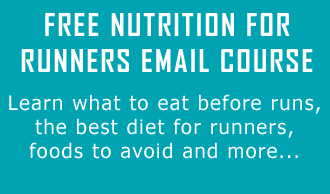A Personal Journey
As I toed the starting line of my eighth marathon, I was focused on hitting my goal time but distracted by the uncomfortably full feeling in my gut. Mindful eating wasn’t part of my vernacular quite yet. After the taper period, travel, and heavy eating from the past few weeks, my body felt lethargic, not ready to tackle a quick (for me) 26.2 miles.
In hindsight, I know I overcorrected for the experience I had a mere seven months earlier, when I ran my seventh marathon feeling depleted and spent. I hadn’t fueled well enough on race day, or the many training weeks preceding it.
This time, I wanted to hit my goal time and I wanted to hit it feeling energized. So I fueled early and often, a tip I give my athletes before every race.
But I also over-fueled at most meals and snacks prior to race day. I took no chances of leaving my muscles and liver depleted of glycogen (please read, The Science of “Bonking” and Glycogen Depletion to learn more).
Fueling For Endurance
But I took that a little too far. Fueling well for endurance training is a challenge. The storybook attempt at getting something “just right” is no small feat (learn how to hydrate “just right” by reading How To Calculate Your Exact Hydration Needs). Mindful eating practices can help an athlete eat enough, not too much or too little.
There are at least three traps that runners fall prey to in pursuit of their personal nutrition goals: intensely focusing on energy balance (calories in and calories out), honing in on specific nutrients instead of overall food satisfaction and ignoring appetite changes as volume or intensity increases.
Each of these traps take the focus away from your natural cravings and food preferences. They also cause you to ignore true hunger and fullness signals. And often lead to less food satisfaction.
Which can lead to overeating later (1). Using mindful eating practices puts the focus back on what an athlete needs and wants, taking the power away from strict food and calorie rules. It helps an athlete tune into their true hunger and fullness (in combination with Intuitive Eating principles), and can be a game changer when it comes to their training progress.
Mindful Or Intuitive Eating
Mindful eating and intuitive eating are sometimes referred to interchangeably. They complement each other, but have distinct differences. With my clients, I start by introducing ways to increase mindfulness and physical awareness before, during, and after meals. That’s what I consider the core of mindful eating.
Without that awareness, it’s harder to recognize true hunger and fullness, or to notice when and why you may be craving certain foods.
Intuitive Eating has ten core principles, which start with ditching a diet mentality, and incorporate some practices of mindfulness (2). You’ll see both mentioned below.
A Six Step Plan
Here are six steps to adopting mindful eating practices into your training (and daily) nutrition. To learn the nutrition habits of an elite athlete, please read, A Detailed Look At The Diet Of An Elite Marathoner.
-
Step 1: Practice Mindfulness
Start by practicing mindfulness during meal time by removing distractions. This means no phones, computers, or television, no jotting down workout notes, or even reading. It may mean eating by yourself for a few meals, to really hone it in. Take at least two days of mindful meal times. Notice how long it takes you to eat a meal, or how much time you allot yourself before you have to rush off to the next thing. And start to notice your physical hunger levels.
-
Step 2: Take Note Before Eating
Notice how hungry you are before a meal or snack. How much food should you eat to satisfy that hunger? Taking a moment to be mindful of true hunger levels before a meal or snack should determine how much you eat. Instead, we have a tendency to focus on set mealtimes and snacks between meals, as that can either be easier to plan for or fits within a set of food rules.
Hunger can pop up anytime, though. This is especially true during training. Ignoring hunger doesn’t do a body good. Being mindful of hunger, and learning to eat in proportion to the hunger you feel is a step toward sufficient food intake to support your training.
-
Step 3: Take Note After Eating
Notice how full you are after a meal or snack. Do you want more food? Could you have eaten less? Satiety is complicated and takes some time to register. Eating slowly and enjoying your meal helps allow the brain and the gut communicate with satiety-signaling hormones (3).
Slowing down, giving yourself more time to eat, and eating without distraction will help you learn to notice signs of fullness.
You may learn that you actually want to eat more or less in order to feel a comfortable sense of fullness. This is your body’s way of communicating that you’ve had enough food for now.
-
Step 4: Forget Calorie Focus
Remove any focus on calories or macronutrient counting. This clouds awareness of true hunger and fullness. Instead, the focus is on math and satisfying a somewhat arbitrary calculation. It doesn’t take into account your workout of the day, stress, sleep, or appetite (among other things).
Removing this focus on numbers and grams allows for space to be mindful of hunger and satiety. With this new mindset you may eat more or less. It doesn’t matter either way, so long as you are mindful of fueling to satisfy your needs.
-
Step 5: All Foods Are Welcome
Allow all foods to fit into your (training and lifestyle) diet. This is one of the core principles of Evelyn Tribole and Elyse Resch’s Intuitive Eating program. While mindful eating is more about mindfulness during and in between meals, Intuitive Eating addresses how to tune into your body’s nutrition intuition. These concepts are complementary though, and I think true mindfulness involves honoring cravings.
Years of following food rules have taught some runners to ignore cravings and go for the nutritious option, but being mindful about cravings is okay. With Intuitive Eating, Tribole and Resch urge everyone to “allow all foods to fit,” and “give yourself permission to eat all foods.”
This means noticing a craving, being mindful about how you satisfy it, and ultimately experiencing more satisfaction with the foods you enjoy. In the absence of restriction, “junk” food cravings lose their power anyway. You can have that food whenever you want it! It becomes less appealing, and you can enjoy your preferred foods anytime.
-
Step 6: Eat To Feel Good
Eat to feel good, and feel good about what you eat. This last step fully incorporates all of the above. Mindfulness during meals can promote an awareness of how foods make you feel physically, especially as you train. You may love a pizza and beer on Friday night, then notice that it doesn’t sit so well during your Saturday morning long run.
Try something else for dinner on Friday, and switch your pizza and beer to Saturday night. Start to notice which foods cause you some stomach discomfort, an energy crash, or any other range of symptoms.
These may not be great pre-workout choices for you, but can fit in your diet elsewhere. In other cases, lethargy and stomach discomfort may be symptoms you wish to avoid altogether, so even though you like the triggering food, you reserve it for unique situations (or stop enjoying it because of these symptoms).
Benefits Of Mindful Eating
In any situation, mindful eating practices will help you identify how food makes you feel. Allowing all foods to fit, and honoring your body’s natural hunger and fullness, will help you feel good about what you choose to eat.
When you combine all of the above, or even just focus on one at a time, chances are you will notice a change in how you feel on the run. Honoring our body is rewarding and an act of self love. Eating when you’re hungry and noticing when your full will help you fuel adequately, which supports your body’s needs during training.
Giving yourself permission to eat all foods you like will reduce feelings of restriction or stress during training, and give you the freedom to savor the foods you enjoy and the sport you love.
To learn more about listening to your body and understanding what it is telling you please read Bonking vs. Fatigue vs. Cramping: What You Need to Know.
Before You Grab That Bag Of Chips
That said, the following situations are ones in which I encourage all athletes to put sports nutrition first, mindful eating a close second.
- Pre-workout snack:
I recommend eating something before most, if not all workouts, but especially long or hard efforts. You may not always feel hungry, but your body will soon need the energy.
- Post-workout recovery:
Again, some athletes experience a loss in appetite immediately following a workout. That doesn’t mean it’s okay to skip your post-workout fueling! It’s important to eat a mix of carbohydrates and proteins to support your muscle and promote recovery.
- Very high volume training:
For elites and other athletes that can sustain a very high volume of running (e.g. >50 miles per week), it can be a challenge to eat enough to support training needs. Hunger and fullness alone may not do the trick, but rather working with a sports dietitian to ensure energy and nutrient needs are met.
Mindful Eating For Endurance Athletes
First, honor the basics of sports nutrition: Eat before and after workouts, even with your appetite feels a little off. Second, ditch the diet mentality. Avoid restriction and strict food rules. Third, trust your hunger. Mindful and intuitive eating involve trusting and honoring hunger with food that satisfy your needs.
And finally, eat for satisfaction, not just satiety. Allowing yourself to eat foods you like, not just “healthy” items, means you’ll be more satisfied with your food choices.
Want To Learn More
For more detailed information about how mindful practices and Intuitive Eating can be combined with sports nutrition, check out the following resources:
- Fit Fueling: Intuitive Eating for Fitness
- How Intuitive Eating Meets Fueling For Fitness
- Intuitive Eating: A revolutionary program that works







